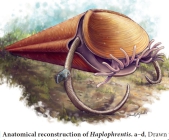MolluscaBase taxon details
Hyolitha †
1644013 (urn:lsid:marinespecies.org:taxname:1644013)
Marek, 1963
accepted
Class
marine, brackish, fresh, terrestrial
fossil only
Marek, Ladislav. (1963). New knowledge on the morphology of Hyolithes. <em>Sborník geologických věd, řada Paleontologie.</em> 1: 63-72. [details]
MolluscaBase (2025). Hyolitha †. Accessed at: https://www.molluscabase.org/aphia.php?p=taxdetails&id=1644013 on 2025-09-12
Date
action
by
![]() The webpage text is licensed under a Creative Commons
Attribution 4.0 License
The webpage text is licensed under a Creative Commons
Attribution 4.0 License
original description
Marek, Ladislav. (1963). New knowledge on the morphology of Hyolithes. <em>Sborník geologických věd, řada Paleontologie.</em> 1: 63-72. [details]
taxonomy source Marek, Ladislav; Yochelson, Ellis L. (1964). Paleozoic Mollusk: Hyolithes. <em>Science.</em> 146(3652): 1674-1675., available online at https://www.science.org/doi/10.1126/science.146.3652.1674 [details] Available for editors [request]
[request]
additional source Devaere, L.; Clausen, S.; Álvaro, J. J.; Peel, J. S.; Vachard, D. (2014). Terreneuvian Orthothecid (Hyolitha) Digestive Tracts from Northern Montagne Noire, France; Taphonomic, Ontogenetic and Phylogenetic Implications. <em>PLoS ONE.</em> 9(2): e88583., available online at https://journals.plos.org/plosone/article?id=10.1371/journal.pone.0088583 [details]
additional source Moysiuk, J.; Smith, M. R.; Caron, J.-B. (2017). Hyoliths are Palaeozoic lophophorates. <em>Nature.</em> 541(7637): 394-397., available online at https://doi.org/10.1038/nature20804 [details] Available for editors [request]
[request]
additional source Li, L.; Skovsted, C. B.; Yun, H.; Betts, M. J.; Zhang, X. (2020). New insight into the soft anatomy and shell microstructures of early Cambrian orthothecids (Hyolitha). <em>Proceedings of the Royal Society B: Biological Sciences.</em> 287(1933): 20201467., available online at https://www.ncbi.nlm.nih.gov/pmc/articles/PMC7482263/ [details]
additional source Liu, F.; Skovsted, C. B.; Topper, T. P.; Zhang, Z.; Shu, D. (2020). Are hyoliths Palaeozoic lophophorates?. <em>National Science Review.</em> 7(2): 453-469., available online at https://doi.org/10.1093/nsr/nwz161 [details]
additional source Martí Mus, M.; Jeppsson, L.; Malinky, J. M. (2014). A complete reconstruction of the hyolithid skeleton. <em>Journal of Paleontology.</em> 88(1): 160-170., available online at https://doi.org/10.1666/13-038 [details]
additional source Marek, L.; Yochelson, E. L. (1976). Aspects of the biology of Hyolitha (Mollusca). <em>Lethaia.</em> 9(1): 65-82., available online at https://doi.org/10.1111/j.1502-3931.1976.tb00952.x [details]
taxonomy source Marek, Ladislav; Yochelson, Ellis L. (1964). Paleozoic Mollusk: Hyolithes. <em>Science.</em> 146(3652): 1674-1675., available online at https://www.science.org/doi/10.1126/science.146.3652.1674 [details] Available for editors
additional source Devaere, L.; Clausen, S.; Álvaro, J. J.; Peel, J. S.; Vachard, D. (2014). Terreneuvian Orthothecid (Hyolitha) Digestive Tracts from Northern Montagne Noire, France; Taphonomic, Ontogenetic and Phylogenetic Implications. <em>PLoS ONE.</em> 9(2): e88583., available online at https://journals.plos.org/plosone/article?id=10.1371/journal.pone.0088583 [details]
additional source Moysiuk, J.; Smith, M. R.; Caron, J.-B. (2017). Hyoliths are Palaeozoic lophophorates. <em>Nature.</em> 541(7637): 394-397., available online at https://doi.org/10.1038/nature20804 [details] Available for editors
additional source Li, L.; Skovsted, C. B.; Yun, H.; Betts, M. J.; Zhang, X. (2020). New insight into the soft anatomy and shell microstructures of early Cambrian orthothecids (Hyolitha). <em>Proceedings of the Royal Society B: Biological Sciences.</em> 287(1933): 20201467., available online at https://www.ncbi.nlm.nih.gov/pmc/articles/PMC7482263/ [details]
additional source Liu, F.; Skovsted, C. B.; Topper, T. P.; Zhang, Z.; Shu, D. (2020). Are hyoliths Palaeozoic lophophorates?. <em>National Science Review.</em> 7(2): 453-469., available online at https://doi.org/10.1093/nsr/nwz161 [details]
additional source Martí Mus, M.; Jeppsson, L.; Malinky, J. M. (2014). A complete reconstruction of the hyolithid skeleton. <em>Journal of Paleontology.</em> 88(1): 160-170., available online at https://doi.org/10.1666/13-038 [details]
additional source Marek, L.; Yochelson, E. L. (1976). Aspects of the biology of Hyolitha (Mollusca). <em>Lethaia.</em> 9(1): 65-82., available online at https://doi.org/10.1111/j.1502-3931.1976.tb00952.x [details]


